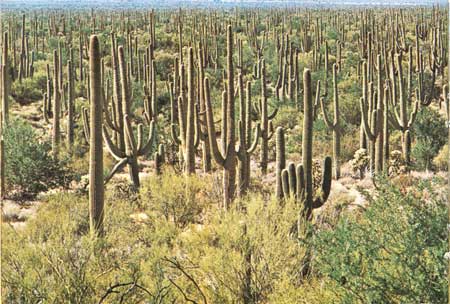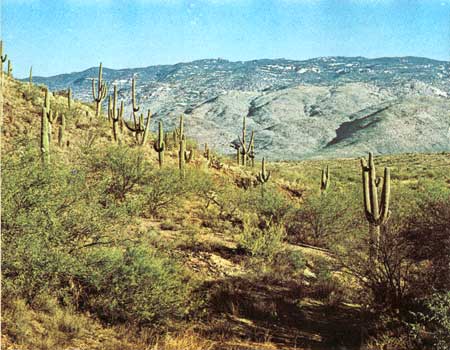|
SAGUARO National Park |
 |
the sonoran desert and the monument
Saguaro National Monument is at the northeastern edge of the Sonoran Desert. Named for the state of Sonora, Mexico, in which the greater part of it lies, this, one of four major deserts in North America, is distinguished by differences in climate and vegetation. The Great Basin Desert, mainly in Nevada and Utah between the Rockies and the Sierra Nevada, has cold winters, sparse precipitation distributed fairly evenly throughout the year, and rather simple vegetation dominated by the low shrubs, sagebrush and saltbrush. Immediately to the south, in southern Nevada and southeastern California, is the Mohave Desert, with cool winters during which most of the year's precipitation comes, and with plant cover consisting mostly of shrubs such as creosotebush. At higher elevations grows the Joshua-tree, a giant yucca. The Chihuahuan Desert, with cool winters and summer rainfall, covers the broad plateau of north-central Mexico, extending into southern New Mexico and west Texas. Its vegetation consists mostly of small cactuses, spiny shrubs, and succulent-leaved plants such as yuccas.
 The Saguaro Forest in the Tucson Mountain Section. (Photo by Harold T. Coss, Jr.) |
Lying between the Mohave and Chihuahuan deserts, the Sonoran Desert has both winter and summer rainfall, with spring and autumn droughts. Its mild winters and bi-seasonal rainfall encourage a vegetation far surpassing in lushness and variety that of the other deserts. From west to east, the land rises and precipitation increases. Yuma, in southwestern Arizona, lying at 141 feet above sea level, gets about 3 inches a year. Tucson, in southeastern Arizona, is at 2,400 feet elevation and averages 11 inches a year. In the western part, where plains are extensive and mountain ranges low and far apart, a very few small-leaved species such as creosotebush dominate. Toward the east, mountain ranges become more numerous, shedding material on which more kinds of plants, particularly paloverde, mesquite, and cactuses, assume leading roles in the vegetative cover. Both sections of the monument lie within the eastern, wetter, more diversified part of the Sonoran Desert known as the Arizona Upland. Organ Pipe Cactus National Monument, to the southwest, is in an area transitional between the Arizona upland and Colorado River lowland phases of the Sonoran Desert.
But even between the two sections of Saguaro National Monument there are differences. There is the obvious fact that the Tucson Mountains are much lower and smaller in mass than the Rincons. And there is the not-so-obvious fact that the Tucson Mountain Section extends to lower elevations (2,200 as opposed to 2,700 feet). These conditions are reflected in the somewhat warmer environment of the western section. This helps to explain why certain Sonoran Desert plants and animals here reach their northeastern limits; among them are ironwood, desert iguana, desert horned lizard, western shovel-nosed snake, sidewinder, desert kangaroo rat, and the Le Conte thrasher. The Rincon Mountain Section, by virtue of its higher elevations, has plants and animals—such as ponderosa pine, Steller's jay, and whitetail deer—not found in the western section.
 Desert Areas of North America. |
On the geologic time scale the Sonoran Desert, like all the earth's present deserts, is a recent development. Some 50 million years ago tropical forests grew here, as they did over most of southern North America. As the Southwest gradually became drier, new species adapted to the new conditions evolved; and the general type of vegetation changed—with some retrogression during wetter periods—from forest to savanna (grasslands with scattered trees) to arid subtropical scrub (such as is now found in southern Sonora State), and finally to the plant communities of today's Sonoran Desert. The last stage has occurred only during the past few million years.
The assemblage of species from which most of our present desert and lower mountain plants were derived is known as the Madro-Tertiary Flora, to denote its center (Sierra Madre in Mexico) and time (Tertiary period—one million to 65 million years ago) of early development. Reflecting these origins, a majority of the species growing below 6,000 feet elevation in the monument today are basically Mexican or Central or South American in their distribution.
On the higher mountains of the Sonoran Desert, however, exist species with an entirely different ancestry. Most of the plants of the pine and fir forests of these high places, like the plants of the Great Basin Desert, derive from the Arcto-Tertiary Flora, which dominated the northern part of our continent during Tertiary times. As climate changes, one or the other of these great plant assemblages will benefit at the expense of the other. If cooler, wetter periods return, as they did during the Pleistocene epoch, ponderosa pines, now found above 6,000 feet, may again grow nearly as low down as today's cactus forests. But if the present long-term drying trend continues, the northern plants will eventually be squeezed off their mountaintops.
Animals, to some extent, reflect the same dichotomy of origins we have seen in the plants. Thus, on the mountaintops supporting pine and fir forests, a northern contingent of animals predominates, while on the lower slopes and desert the fauna has a Mexican character. The canyons and oak-pine forests of middle elevations in southeastern Arizona are particularly exciting, because in these biological islands, isolated by surrounding desert, live many "Mexican" species of animals found nowhere else in the United States. Naturally, mountain ranges nearest the border—such as the Huachucas and Chiricahuas—have the greatest number of Mexican specialities; but the Rincons have their share too.
The wonderful diversity of plant and animal life in Saguaro National Monument depends on a diversity of habitats. These in turn owe their existence to a widely varying triumviragte of environmental factors—climate, soil, and topography. To understand the biological interplay that goes on here, we first must knkow something of the evnironmental conditions that circumscribe it.
 Plant communities on Mica Mountain. (Photo by Harold T. Coss, Jr.) |
Geological Time Table
| Era | Period | Epoch | Years before present time | Major geological events |
| Cenozoic | Quaternary | Recent | 10,000 | Cascade Range and Sierra Nevada uplifted |
| Pleistocene | 1,000,000 | |||
| Tertiary | Pliocene | 12,000,000 | ||
| Miocene | 26,000,000 | |||
| Oligocene | 38,000,000 | |||
| Eocene | 54,000,000 | |||
| Paleocene | 65,000,000 | Rocky Mountains formed | ||
| Mesozoic | Cretaceous | 136,000,000 | ||
| Jurassic | 195,000,000 | |||
| Triassic | 250,000,000 | Appalachian folding | ||
| Paleozoic | Permian | 280,000,000 | ||
| Pennsylvanian | 320,000,000 | |||
| Mississippian | 345,000,000 | |||
| Devonian | 395,000,000 | |||
| Silurian | 440,000,000 | |||
| Ordovician | 500,000,000 | |||
| Cambrian | 570,000,000 | |||
| Precambrian | ||||

|

|
| NPS History | History & Culture | National Park Service | Contact |
|
Last Modified: Sat, Nov 4 2006 10:00:00 pm PST |


